In-house sketching and rendering techniques showing simultaneous design development and rendering of real-world projects. All projects are collaborations between NYC architect, illustrator and architectural rendering consultant James Akers and his NYC and Boston architect clients
Architectural Rendering Technique: The Art Of The Pen and Ink Sketch
Pencil Sketching is the New Computer Aided Design
As digital modeling and architectural digital rendering continue to chnage our industry for the better, the arts of architectural rendering and architectural sketching in watercolor, pencil, and pen-and-ink become huge asstes in the constant battle to stand out among competitors all using the same digital tools.
 Architectural sketching and storyboarding in watercolor
Architectural sketching and storyboarding in watercolor
They engage clients' emotions, connecting with that deep thing that persists in all of us--that ability to...
Architectural Sketching and Rendering For The Digital Rendering Age
 Above: This architectural sketch (or what some might call an architectural rendering) in pencil shows the architect's design concept for an underground book storage addition to the Princeton University library. Visualizing the design concept in quick pencil sketches not only engaged the client in an attention-grabbing ad humanistic way, it also served as a kind of art direction to help guide the third party architectural digital renderers.
Above: This architectural sketch (or what some might call an architectural rendering) in pencil shows the architect's design concept for an underground book storage addition to the Princeton University library. Visualizing the design concept in quick pencil sketches not only engaged the client in an attention-grabbing ad humanistic way, it also served as a kind of art direction to help guide the third party architectural digital renderers.Ahh the Smell of Pen and Ink Architectural Rendering in the Morning
Pen, ink and tracing paper remains one of the effective forms of architectural rendering ever devised, but what if we combined it with photoshop and a digital aesthetic?

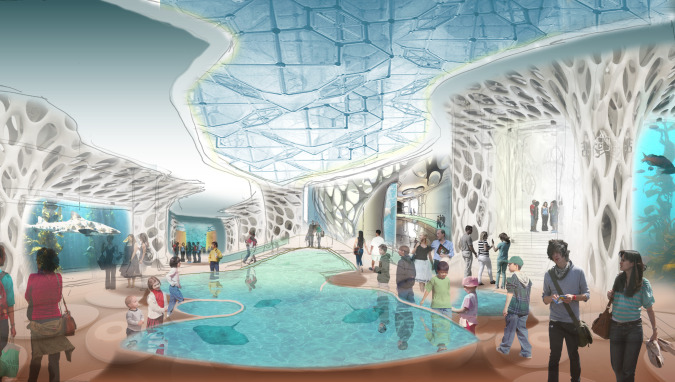
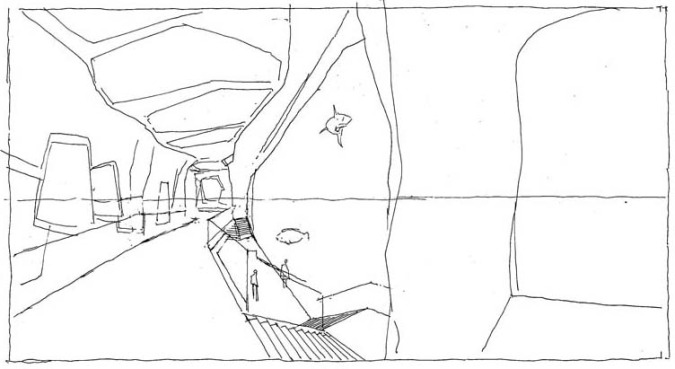
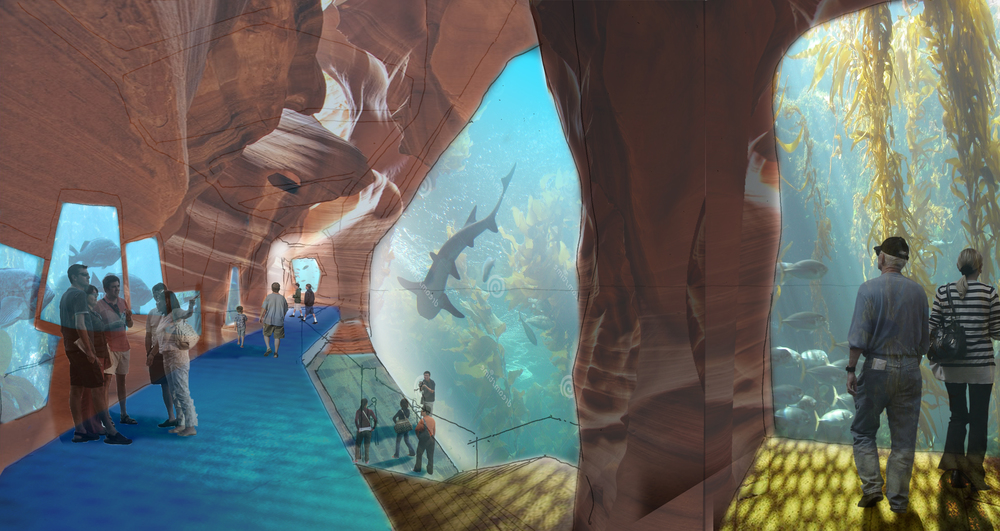
This architectural rendering project was a lot of fun, done right in the architect's office with close collaboration between architect and architectural illustrator. I would love to know what you think? Please leave coments below.
(The author is a registered architect and architectural illustrator with years of experience helping architects and interior designers develop and present their ideas in dramatic and cost-effective ways. From concept design to final presentation, we work in your office or from our NYC studio. 413-250-8800.)
Pitch Your Schematic Design Ideas With Digital Sketches, NOT Digital Or Traditional Architectural Renderings
Presenting schematic architectural and interior design ideas to your client in the digital age can be challenging. The problem? The photo-literalism of digital images can, if presented too early, elicit an equally literal response in your client and put the organic “Concept-to-DD-to-CD” design process at risk.

Like all technological advances, digital architectural rendering presents us with a double edged sword. On the one hand, digital software gives designers the unprecedented power to present schematic design ideas as photorealistic fait accompli. On the other hand
Use Digital Architectural Sketching To Streamline Client Approvals
It's one week before your next big design meeting. You have multiple ideas to present, but your goal is to secure your client's approval of a single direction so you can complete this phase, bill for it and move your team on to the next.

Back in the day, architects solved this problem by presenting loose architectural sketches (with maybe a little color thrown on them), blown up several feet wide so as to wow the client with vagueness...but times have changed and clients have changed with them.

Modern clients have grown up in a world of photo-realistic digital images.Their parents understood that hand drawn sketches and diagrams were a part of the design development process, but this generation has
Traditional Architectural Rendering Plus Digital Architectural Rendering Equals Hybrid Architectural Rendering
Architects have had to be resourceful since the bankers brought the global economy to its knees in 2008. I mean, we taxpayers with jobs couldn't let the bankers starve, could we? Still, after we shared our own after-tax income to save these valuable executives and restore their bonuses, architects (and a few other professions) had the problem of finding work to replace that income. (OK, I'm being silly here. Nothing said the rest of us had to maintain our lifestyles or send our kids to college.) That's when we began re-inventing ourselves: finding new clients, downsizing our firms, exploring more efficient ways to deliver services and get the ball rolling again.
 My thanks to my friend Chad Rush for his help in coloring this puppy
My thanks to my friend Chad Rush for his help in coloring this puppy
One of the ways that architectural renderers have reinvented themselves is to blend the world of traditional architectural rendering with digital architectural rendering, resulting in the so-called hybrid architectural rendering. Some argue that the hybrid architectural rendering combines the best of both into a compelling new form that connects the work with the emotions of the client and helps architects differentiate themselves from the pack. Others just think it looks cool and gives the client more options to quickly explore a mood or time of day.
 Here is the original pencil tone drawing of a proposed nightclub terrace in Las Vegas. (Architect's name withheld by request)
Here is the original pencil tone drawing of a proposed nightclub terrace in Las Vegas. (Architect's name withheld by request)
Whatever your opinion, I hope you will...
Hybrid Architectural Renderings Mix Traditional Architectural Renderings Techniques With Photoshop
We've talked quite a bit about hybrid architectural renderings in this blog. A hybrid architectural rendering is any rendering that mixes traditional and digital techniques so as to leverage the best characteristics of both.

Traditional architectural rendering, as the argument goes, communicates at some deep level in the human brain, connecting people--even against their will, Don Draper might say--with emotions still stirred by handmade artifacts, as in a handmade drawing or painting.
Digital architectural rendering techniques, on the other hand, brings advantages no human artifact can compete with: the illusion of photo-realism; the advantages of infinite visual adjustment in very little time, and my favorite:
New Trends In Traditional and Digital Architectural Rendering
If you are an architect, landscape architect, interior designer or traditional or digital architectural renderer, the world changed in 2008: work dried up, firms cut their payrolls, and up to 50% of us lost our jobs and had to reinvent ourselves.
 A hybrid architectural rendering combining digital and traditional techniques to project the accessibility of a proposed children's museum.
A hybrid architectural rendering combining digital and traditional techniques to project the accessibility of a proposed children's museum.
 Hybrid architectural rendering of seasonal decoration scheme for world's most famous fish marketThose who survived were sobered by the central lesson of the new economic order:
Hybrid architectural rendering of seasonal decoration scheme for world's most famous fish marketThose who survived were sobered by the central lesson of the new economic order:
How To Find An Architectural Renderer
These days it is no easy task to find an independent architectural renderer. With every architectural graduate student now capable of creating digital architectural renderings, the registered architects who practice watercolor techniques, architectural rendering, architectural watercolor rendering, architectural sketching, watercolor rendering techniques, architectural sketches, watercolor techniques, architectural rendering or any of the other disciplines associated with traditional architectural rendering are becoming harder to find.
My name is James Akers, I am a licensed architect and I specialize in watercolor techniques, architectural rendering, architectural watercolor rendering, architectural sketching, watercolor rendering techniques, architectural sketches, watercolor techniques, architectural rendering and all of the other disciplines associated with traditional architectural rendering. Email me at jakers3 at gmail dot com, or call me at four-one-three 250-8800 to discuss what you need, and how to provide it in the quickest, most affordable way possible. Thanks.
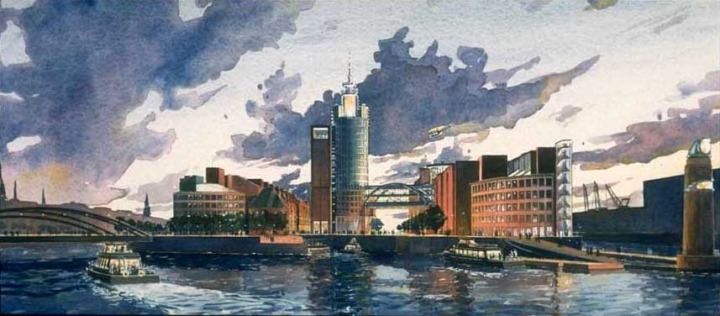
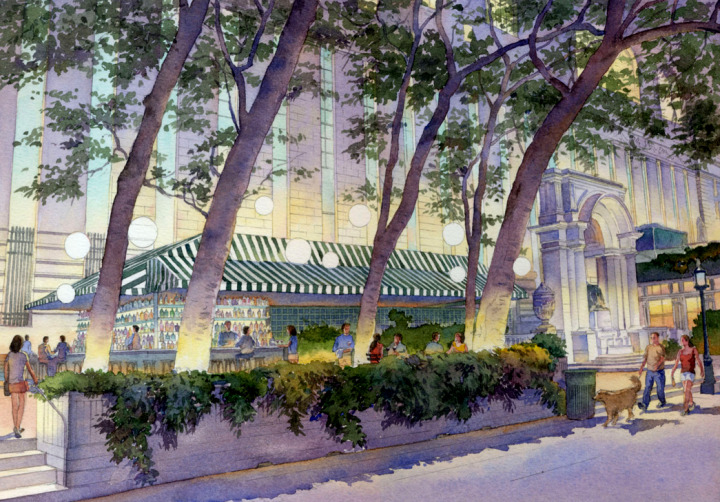

Architectural Renderings and Storyboards for Proposed Theme Park
Pen and ink sketches are less expensive than traditional watercolor renderings, but they bring energy and human touch to the presentation of conceptual architectural designs. Nothing differentiates your firm from your competitors more than the idea that you still "sketch on the back of a napkin."
The following sketches for an imaginary theme park were commissioned by one of the world's most famous and enduring sports franchises. (With gratitude to Charles Rush for his excellent work adding Photoshop color to these sketches.)

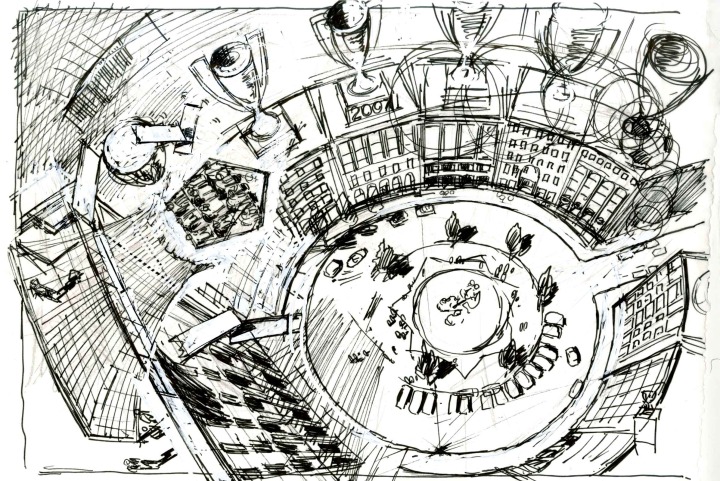


Appendix: Here are some keywords which will help readers index this article:
- architectural rendering
- watercolor techniques
- architectural renderings
- architectural rendering techniques
- watercolor rendering techniques
- pen and ink techniques
- watercolor rendering
- watercolor techniques
- architectural sketches
- watercolor rendering techniques
- watercolor techniques
- architectural watercolor rendering techniques
- pen techniques
- different watercolor techniques in rendering
- architectural sketching
- pen and ink
- sketching techniques
- architectural rendering in watercolor
- rendering watercolor
My Friend Jim Is Cool
My friend Jim Bouton is cool because he a) pitched for the Yankees (and my next coolest baseball-related friends Dave Bell and Jack Lauer only played for Madison High School varsity, although come to think of it they both played against Willie Wilson for two seasons when Willie played for Summit High School) b) he wrote two famous books about pro baseball--Ball Four and Foul Ball--and c) because he put my name in the second book, and there is nothing cooler than when someone puts your name in their second book...
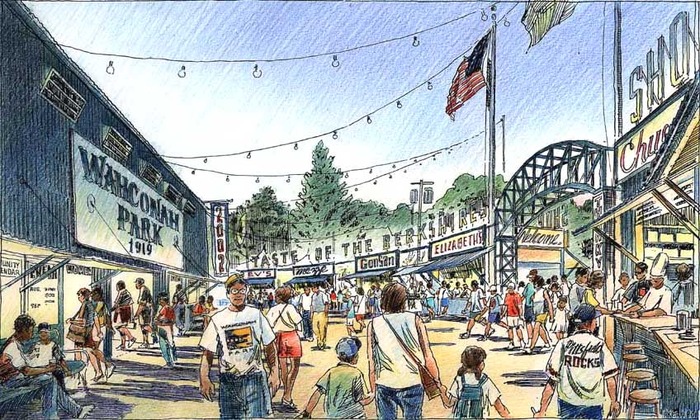 The proposed future promenade of the renovated stadium. Come on, how cool would that have been?
The proposed future promenade of the renovated stadium. Come on, how cool would that have been?






